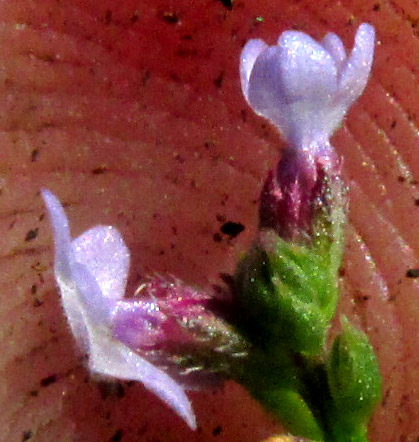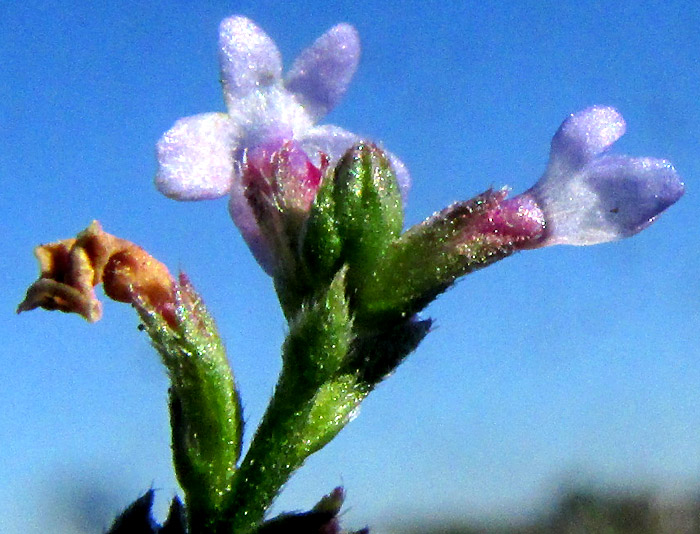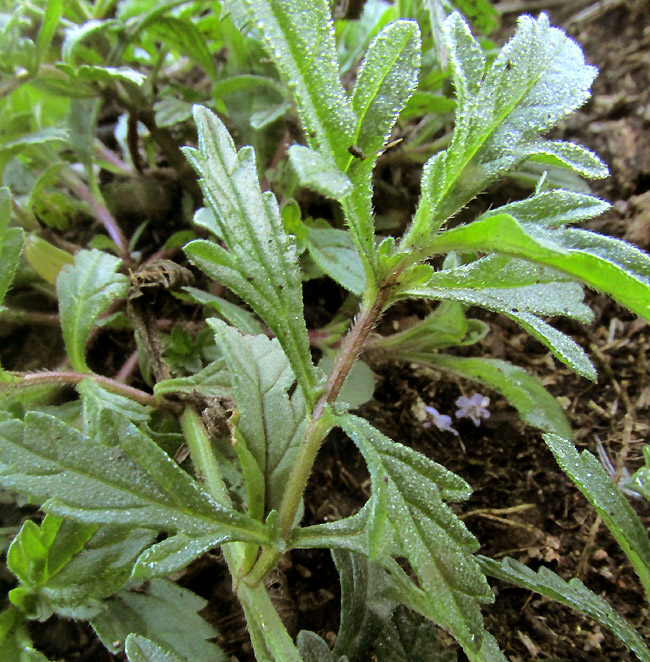Excerpts from Jim Conrad's
Naturalist Newsletter
Entry dated December 29, 2023, issued from near Tequisquiapan; elevation about 1,900m, (6200 ft), ~N20.57°, ~W99.89°; Querétaro state, MÉXICO
EHRENBERG'S VERVAIN

In alluvial soil at the base of a vertical cliff of basalt rock, the above plant with its slender, stem-tip spikes of tiny flowers lived in deep shade most or maybe all of the day. A few steps from the cliff, on the wide, flat valley floor, the soil was very dry and the vegetation was dead and parched; we're experiencing a continuing two-year drought described by the online North American Drought Monitor as a D3 Extreme Drought, after a rainy season that simply didn't develop. Our flowering plant definitely flourished because of its shadowy microclimate.

The flowers produced pale blue corollas only about 1.5mm across (0.06inch) and were arranged in slender spikes with open flowers only at their tops; below the open flowers, ovaries developing into fruits got older and more mature the lower down the stalk, or rachis, they appeared. Taking into account the plant's general appearance, with pairs of leaves appearing opposite one another on the stems, and the slender spikes of tiny, blue-spectrum flowers, those who know their common wildflowers and weeds may already recognize a member of Verbena or Vervain Family, the Verbenaceae. With such slender spikes elongating as flowering continues, and the individual flowers with their bluish color leaning a little away from the rachis, one assumes it's a Verbena itself; and that's what it proved to be.

Unlike most corollas, which are either clearly radially symmetrical or else obviously bilaterally symmetrical, often it's hard to decide which way a Verbena corolla is. The ones shown at the right tend toward the bilaterally symmetrical kind, though without much enthusiasm. Here's another view, showing how the corolla's top two lobes are smaller and closer together than the others:

Above, also notice that scale-like bracts subtending each flower are shorter than the calyx above them; that helps distinguish this species from others. However, for this particular plant, identification to species level depended more on leaf shape than flower structure:

Most leaves were deeply lobed, with edges between the lobes bearing a few irregularly shaped teeth. In the above picture, notice that the stems are squared in cross section, and that the whole body is shortly stiff-hairy, with hairs angling somewhat toward the plant's surface; they're strigose.
Currently Kew's Plants of the World Online database lists 150 Verbena species. In our part of upland central Mexico known as the Bajío Region, about eight have been documented. In this area, if you have a wild Verbena with most of its leaves tending to be more or less three-lobed as shown above, and the flowers are as small as ours on such slender spikes, you have VERBENA EHRENBERGIANA, which at least in some publications is known as Ehrenberg's Vervain.
Verbena ehrenbergiana is endemic just to Mexico, from northern Mexico south to about Mexico City in the central highlands. Keeping below about 1600m (5250ft) in elevation, it lives in disturbed temperate environments in the mountains and in the altiplano's semiarid scrublands. Considered neither rare nor common, it's easy to confuse with similar species, its identification maybe needing a gestalt approach. It's close to Verbena carolina, whose leaves are not so pronouncedly 3-lobed. Also there's Verbena menthifolia, whose leaves bear more teeth and are more regularly arranged.
I find no mention of Verbena ehrenbergiana being used in traditional medicine, possibly because of its similarity to other more commonly encountered species. The online Atlas de las Plantas de la Medicina Tradicional Mexicana Verbena lists numerous uses of the similar and more common Verbena carolina, and I suspect the two species could be used interchangeably.
Seeing how our plant was the only one managing to flower in the cliff's shade during such a severe and long-term drought, possibly Verbena ehrenbergiana may have a bright future extending its presence into more and more of the Earth's habitats succumbing to desertification.